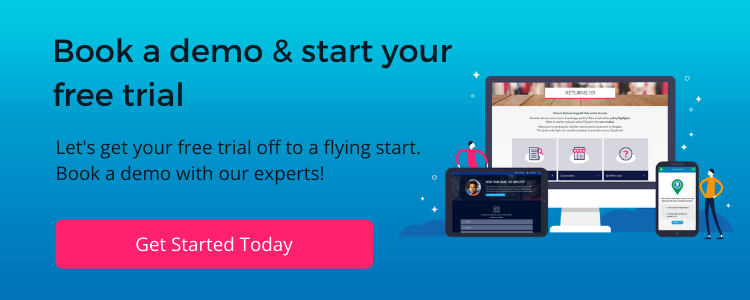8 tips to drive performance through scalable learning
6 minute read
With scalable learning billed as the key strategic differentiator in the 21st century, it’s an exciting time for corporate learning teams. L&D can truly impact performance and competitive advantage – as long as it shifts from being a support function to being a center of excellence for decentralized learning.

What is scalable learning?
Scalable learning isn’t just about finding ways to roll out more content to more people. It’s about rethinking the role of L&D, reorienting itself from producing and delivering content, to instead:
- uncovering and amplifying knowledge and expertise across the organization – including working with subject matter experts (SMEs) to let them author content directly;
- connecting people and facilitating the sharing of knowledge and skills (something that Boots Walgreen Alliance does well, as Miguel Premoli shared with us on the Learning at Large podcast);
- acting as a center of excellence, setting the standard for and supporting efficient, high-quality decentralized learning; and
- encouraging a culture of constant, in-the-workflow learning and development.
The term was originally coined by John Hagel, co-founder of the Deloitte Center for the Edge and still the most authoritative voice on the topic. Hagel says that scalable efficiency (a focus on standardized processes, activities and products) used to be the key driver of success for large organizations, but the world (and work environment) has changed and those organizations now need to focus on scaling learning instead.
To do this, they need to focus on learning through action, on-the-job learning, peer-to-peer learning, in-the-workflow learning. Scalable learning is driven by employees – the things they need to do and the challenges they face – rather than by what the business thinks people need to know and learn. Its success relies on finding, empowering and engaging subject matter experts across the organization.
Why you need to be able to scale learning
Large companies can’t afford to ignore this; it is crucial for competitive advantage and talent attraction.

The criteria of top performance have changed
In the era of scalable efficiency, success and top performance were defined by mass production and standardization. But this came at the expense of learning, development and innovation.
Now organizations need to respond to vastly expanded competitor landscapes, fast-changing marketplaces, evolving consumer demands and emerging technology. They’re finding that they need to redefine excellence: top performance is now defined by innovation, adaptability and speed of learning.
“The scalable efficiency institutional model is inherently a diminishing returns model – the more efficient these institutions become, the longer and harder they will need to work to get to the next increment of performance improvement. Scalable learning, on the other hand, for the first time offers the potential to shift to an increasing returns model where the more people who join together to learn faster, the more rapidly value gets created.” – John Hagel and John Seely Brown
Organizations that can scale learning attract the best talent
Just as organizations need to constantly adapt to avoid obsolescence, so too do individuals. In the modern workplace, employees both need and want to feel they’re developing meaningfully and building new skills.
Large employers that scale learning effectively – offering the opportunity to learn faster than the individual ever could alone, or at a smaller company – are therefore attractive propositions. “The most impactful development happens not through formal programs, but smaller moments that occur within the workplace: on-the-job learning opportunities that are wholeheartedly catered to the worker’s unique needs and challenges.” – Margaret Rogers.
8 tips for delivering learning at scale, and the tools you need
Scalable training and learning can’t be achieved through technology alone, but having the right tool can make or break your scalable learning strategy! Hagel describes it as harnessing technology to augment the capabilities of people.
Here are our tips to help you start realizing the potential of scalable learning in your organization, and some things to keep in mind when looking for the software, solutions and platforms to help you do it.
1. Focus on performance
Make learning a by-product, not the end goal; that should always be business performance and results. Spend time finding out where the pain points are, identifying the problems you’re trying to solve, and establishing how to maximize impact.
2. Decentralize L&D: ask questions and let SMEs answer them
This is perhaps a big mindset shift for L&D. Hagel describes the most effective leaders in scalable learning environments not as know-it-alls but as the people asking the powerful questions. L&D needs to do the same: identify those pain points, engage subject matter experts in addressing them, and let them create their own content. A scalable learning tool that offers collaborative content production will make that involvement seamless and efficient.
3. Establish L&D as a center of excellence
As learning becomes more decentralized, and SMEs begin producing content themselves, L&D needs to become the center of excellence. Rather than being the source of all content, focus on setting the standard and showing what great content looks like. Produce best practice templates others can draw on, source great and easy-to-use tools for authoring and rolling out content, and provide guidelines to help them get the best from those tools.
4. Personalize and localize
Uncover employee needs in different roles, functions, groups and locations and then tailor what you offer to those different audiences. Melissa Taylor talked to us about how Porter Novelli balances centralized offerings with local leadership of learning. Look for scalable learning platforms that include version or variation managers, translation and localization features (Elucidat offers all three, and more) to make adding, tracking and updating multiple versions a piece of cake).
5. Break down silos
Encourage people to share and collaborate: a culture where people improve themselves solely to get ahead isn’t compatible with scalable learning. Technology can really help with facilitating sharing and learning across business units, locations and job roles. As well as collaboration and social platforms, look for tools that let you roll out content to groups both within and outside your organization.
6. Don’t reinvent the wheel
The goal of scalable learning is enabling people to learn faster and better. Often, there’ll be people and resources outside your organization that can fill knowledge or skills gaps. Not everything needs to be bespoke to your business or secured within your IT infrastructure. If people can quickly, easily and affordably get what they need externally, let them.
7. Streamline content production
Delivering learning at scale means putting it in the hands of the experts across the organization (so that L&D isn’t a bottleneck for content production), but also making it as easy and efficient as possible for them to create content that looks good and is effective. Look for a tool that lets SMEs author directly and makes it easy to reuse templates and assets. Elucidat even lets multiple authors, contributors and reviewers collaborate at once.
8. Remain people-centered
We recently reviewed our Learning at Large podcast interviews to explore how organizations are successfully tackling the challenges of learning at scale. The common thread is a people-centered approach underpinning everything else (advanced technology, creative media, innovative design methodologies and so on). The L&D leaders that put people at the center of their learning strategies are the ones causing the biggest ripples inside and outside their organizations.
In summary…
We live in a world and workplace that are very different from how they were even a decade ago; the place of learning and the role of L&D need to change as well. Rather than L&D imposing solutions and products from the top down, we need to facilitate collaboration and peer-to-peer learning.
Scalable learning done well uses the right tools and technology to find and amplify skills, knowledge and expertise across the organization. It empowers subject matter experts to share their knowledge, author and produce content, and directly impact business performance.
Find out how Elucidat can help you deliver content at scale
The goal of scalable learning is driving innovation and accelerating performance improvement. If this is something you want to achieve (and why wouldn’t you?), contact us to book a demo.




